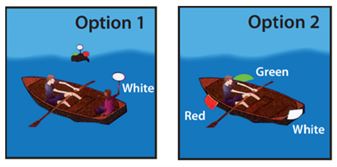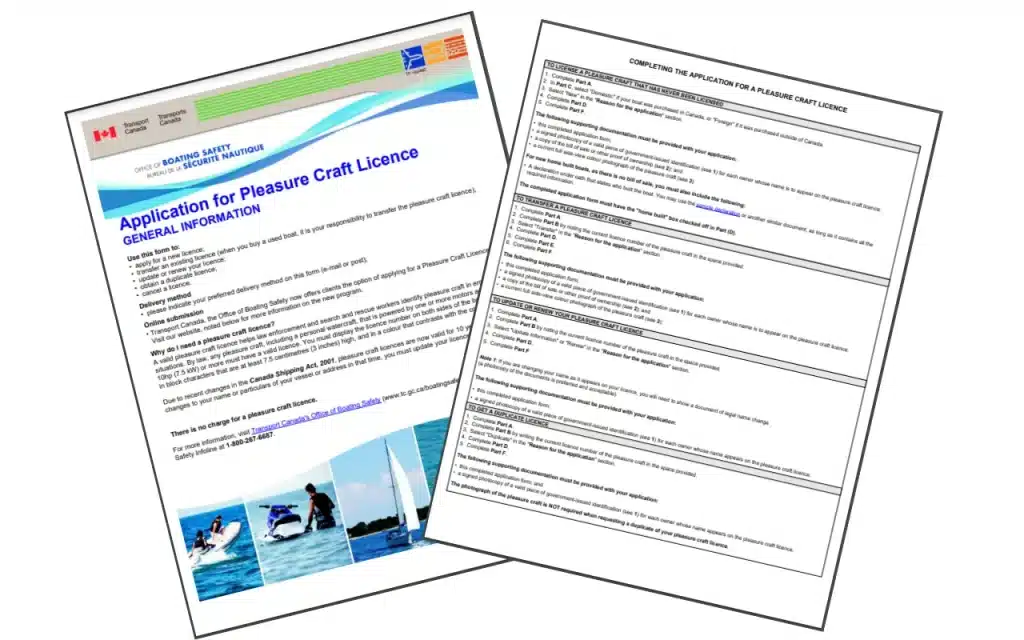Home / Boating Safety Manual / Required Navigation Lights for Boating in Canada
10% OFF WITH CODE:
BLACKFRIDAY10
Navigation lights are a mandatory safety feature for pleasure craft, and they are governed by clear rules.
You must use them at night (sunset to daybreak) and whenever visibility is reduced during the day by fog or bad weather.
You must use the correct type of light (and combination) according to the length and type of boat you are operating.
Light colours and combinations also vary based on whether you are at anchor or moving, and whether your boat is motorised.
And that’s not all. Keep reading to learn what you need to know about the rules and regulations governing navigation lights for boats on Canadian waters.
Key takeaways
- Navigation lights must be displayed between sunset and daybreak (“night”), or at any time during the day when there is poor visibility (e.g., fog, heavy rain, or snowfall).
- Two main Canadian regulations apply: the Small Vessel Regulations and the Collision Regulations.
- Navigation lights help prevent collisions because they allow operators to determine three key things about a nearby vessel: the direction it is traveling; whether it is a power-driven vessel or a sailboat; whether the vessel is moving (underway) or anchored.
- There are several different types of navigation lights, and the rules governing when to use which types (colours), and which combinations of lights, are determined by the length and type of boat.
Table of contents
- Regulations applying to navigation lights
- Small Vessel Regulations
- Collision Regulations
- Types of boat navigation lights and colour
- Navigation light requirements by boat type and length
- Power boats under 12 m (39’4”)
- Power boats from 12 m (39’4”) to under 50 m (164’1”)
- Sailboats under 7 m (23’)
- Sailboats from 7 m (23’) to under 20 m (65’7”)
- Sailboats 20 m (65’7”) and over
- Human-powered boats
- Anchored boats under 7 m (23’)
- Anchored boats from 7 m (23’) to 50 m (163’1”)
- General safety considerations for navigation lights
- Frequently Asked Questions
Regulations applying to navigation lights
There are two regulations that apply to navigation lights in Canada.
Small Vessel Regulations
The Canadian Small Vessel Regulations (SVR) outline which safety equipment must be carried on board according to the type of boat you have and its size. All equipment, including navigation lights, must be in excellent condition and tested before each boat outing, according to the SVR.
Collision Regulations
In addition, Canada’s Collision Regulations specify how and when to use navigation lights. Operators must be able to identify other boats travelling in the vicinity and determine which direction they are travelling, whether the boat is power-driven or a sailboat and whether the boat is moving or anchored by checking the navigation lights in order to avoid a collision.
For effective collision avoidance, operators are required to use navigation lights to determine the following for every vessel in the vicinity:
- Course: The direction the vessel is traveling.
- Propulsion: Whether the vessel is power-driven or a sailboat.
- Status: Whether the vessel is moving or anchored.
Types of boat navigation lights and colours
Below is a list of the many types of boat navigation lights, along with the colours that correspond to them:
- All-round light: a light that shines continuously over a 360-degree arc of the horizon
- Side lights: a green light near the bow on the starboard side and a red light near the bow on the port side, each showing an uninterrupted light across an arc of the horizon of 112.5 degrees
- Stern light: a white light set as close to the stern as feasible, displaying an uninterrupted light over a 135-degree arc of the horizon
- Masthead light: a white light at the fore and aft centreline of the boat that must be visible from two miles distant and across 225 degrees
- Blue flashing light: an all-around blue flashing light that identifies government and law enforcement (police) vessels
- Yellow light: a yellow light is used when a vessel is towing and has the same features as a stern light
- Special flashing light: a yellow light placed at the front end of a towing vessel or a vessel being towed
Navigation light requirements by boat type and length
As a boater, you should always double-check to ensure that you have the proper navigation lighting for safe and legal boating. Here are the various requirements for each type and length of boat:
Power boats under 12 m (39’4”)
- 1 masthead light (with a second masthead light being optional)
- Sidelights and 1 stern light OR 1 all-round white light and sidelights
Power boats from 12 m (39’4”) to under 50 m (164’1”)
- 1 masthead light (with a second masthead light being optional)
- Sidelights and 1 stern light
Sailboats under 7 m (23’)
- Sidelights
- 1 stern light, and
- OPTIONAL – 2 all-round lights in a vertical line, the upper being red and lower green
OR
- 1 lantern, combining the sidelights and stern light above
OR
- Have a white-lighted electric torch or lantern that you must use far enough ahead of time to avoid a collision
Sailboats from 7 m (23’) to under 20 m (65’7”)
- Sidelights
- 1 stern light, and
- OPTIONAL – 2 all-round lights in a vertical line, the upper being red and lower green
OR
- 1 lantern, combining the sidelights and stern light above
Sailboats 20 m (65’7”) and over
- Sidelights
- 1 stern light, and
- OPTIONAL – 2 all-round lights in a vertical line, the upper being red and lower green
Human-powered boats
- Have a white-lighted electric torch or lantern that you must use far enough ahead of time to avoid a collision
- OR
- The same lights as listed above for sail boats, with the same boat length taken into account
Anchored boats under 7 m (23’)
If the boat is in or near a small channel, fairway, or anchorage, or in an area where other boats regularly navigate:
- 1 all-round white light at night or 1 ball during the day, and
- An additional all-round white light
OR
- 1 all-round white light
Anchored boats from 7 m (23’) to 50 m (163’1”)
If the boat is in or near a small channel, fairway, or anchorage, or in an area where other boats regularly navigate:
- 1 all-round white light at night or 1 ball during the day, and
- An additional all-round white light
OR
- 1 all-round white light
General safety considerations for navigation lights
Always test your navigation lights before heading out on the water.
Do not show any other lights (like spotlights or deck lights) that could interfere with the required navigation lights or be mistaken for them. Do not use home-made lights or alternative types of lights, and these are unreliable, potentially not bright enough, and possibly dangerous to your boat (if flammable).
Get your boating licence with Drive A Boat Canada!
We offer a comprehensive online course leading to lifetime certification. Register with Drive a Boat Canada today, and learn everything you need to know to pass the boating exam. With your boating licence (PCOC), you can take to the water legally anywhere in the country.
Frequently Asked Questions
You must display the appropriate navigation lights from sunset to sunrise. You must also display them at any time during the day when visibility is restricted (e.g., in fog, heavy rain, or snow).
A sailboat operating with its engine running (even if the sails are up) is legally considered a power-driven vessel. It must display the lights required for a power-driven vessel of its size.
When anchored, your boat must display an all-round white light that can be seen from any direction, often called an anchor light.
Sources
- Transport Canada. SAFE BOATING GUIDE. [PDF]. https://tc.canada.ca/sites/default/files/2024-03/tp_511e.pdf
- Government of Canada Small Vessel Regulations. Department of Justice. https://laws-lois.justice.gc.ca/eng/regulations/sor-2010-91/page-4.html
Last articles











